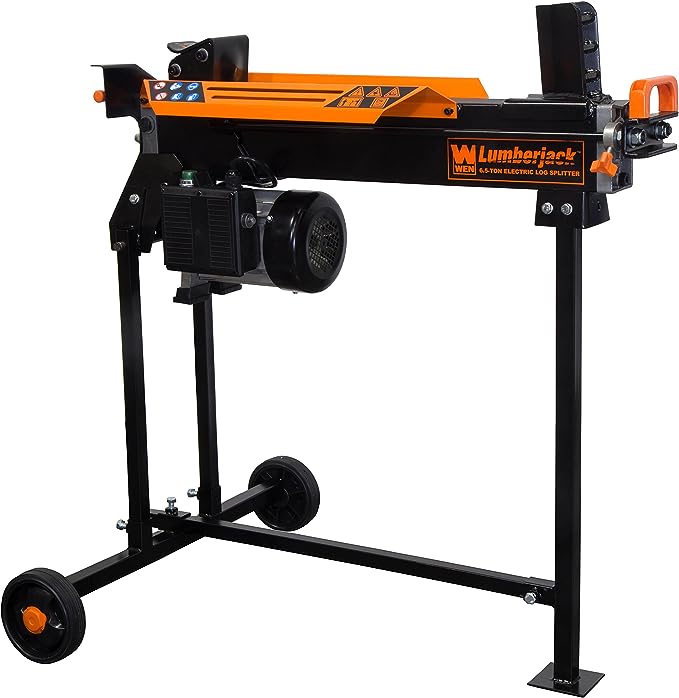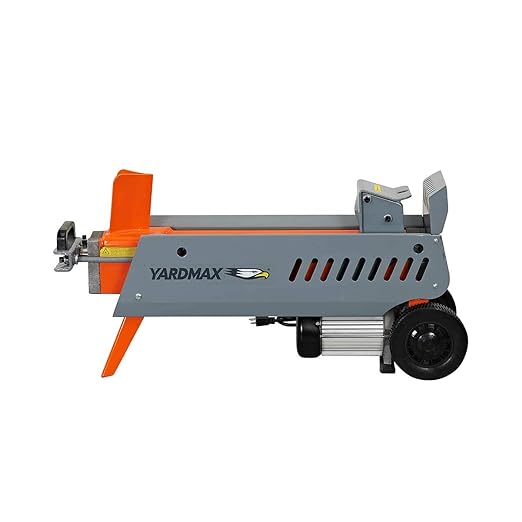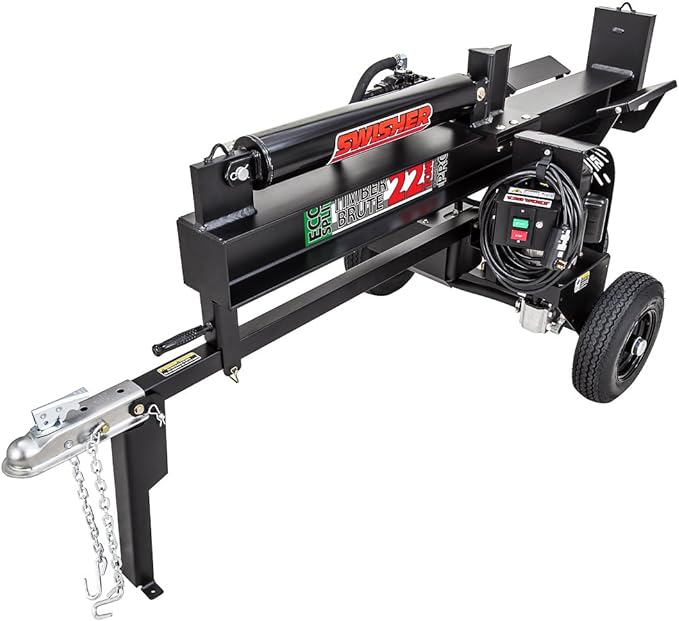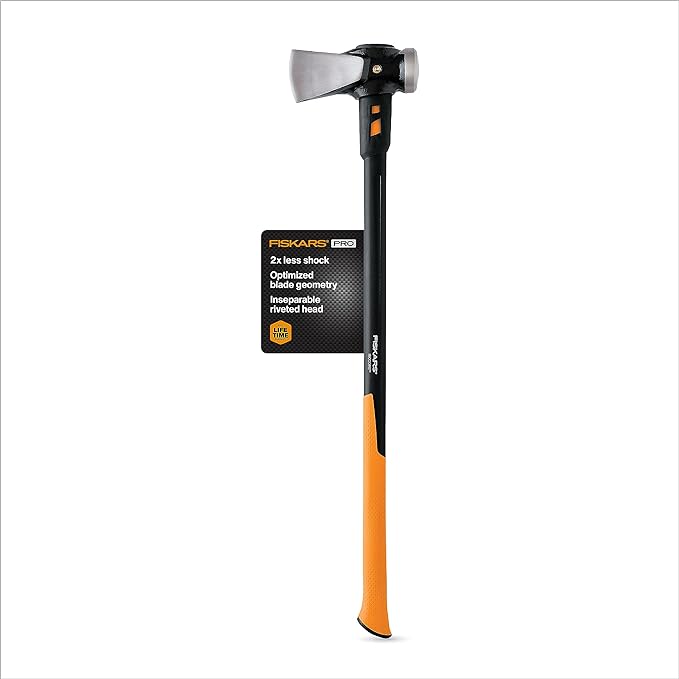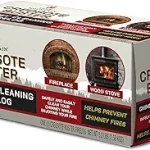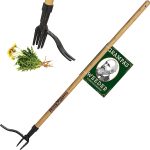You’re searching for a reliable log splitter to tackle your firewood needs, and you’re not alone – many homeowners struggle to find the right tool for the job. Whether you prefer electric, gas-powered, or manual models, finding the perfect fit can be overwhelming. From 7-ton electric log splitters to heavy-duty gas-powered machines, and even manual tools for a more hands-on approach, the options are vast. But which ones stand out from the rest?
Contents
- ES7T20 Electric Log Splitter, 7-Ton
- WEN 56208 6.5-Ton Electric Log Splitter with Stand
- ESTWING Sure Split Wedge Wood Splitting Tool
- YARDMAX YS0952 9 Ton Log Splitter
- Swisher Timber Brute Eco Split Electric Log Splitter
- Firewood Splitter Wood Splitter Wedge
- Fiskars IsoCore Wood Splitting Maul
- Factors to Consider When Choosing Log Splitters
- Frequently Asked Questions
- Conclusion
ES7T20 Electric Log Splitter, 7-Ton
If you’re looking for a reliable and compact log splitter that can handle small to medium-sized logs with ease, the ES7T20 Electric Log Splitter, 7-Ton is an excellent choice, boasting a powerful 2 HP electric motor and 7 tons of splitting force.
This electric log splitter is designed to make your wood-splitting tasks easier and more efficient.
Weighing 121 pounds, it’s relatively lightweight and easy to maneuver, making it perfect for small to medium-sized logs.
Plus, its compact dimensions (13.5 W x 20 H x 39.5 D) allow for easy storage when not in use.
With its automatic ram return and convenient one-handed operation, you’ll be able to split logs quickly and effortlessly.
Best For: Homeowners who need to split small to medium-sized logs for their woodstove, fire pit, or outdoor use, and require a compact and quiet electric log splitter.
Pros:
- Compact and lightweight design with a small footprint, making it easy to store and maneuver
- Powerful 2 HP electric motor with 7 tons of splitting force, suitable for small to medium-sized logs
- Quiet and fume-free operation, with automatic ram return and convenient one-handed control
Cons:
- 14-second cycle time may be slow for some users
- Air release wing nut on hydraulic ram can be problematic and require frequent checking
- One-handed operation may be a con for some users who prefer a two-handed operation
WEN 56208 6.5-Ton Electric Log Splitter with Stand
You’ll want to explore the WEN 56208 6.5-Ton Electric Log Splitter with Stand if you need a powerful and eco-friendly log splitter that can handle logs up to 10 inches in diameter and 20.5 inches in length.
This electric log splitter is a great option for those who want to avoid gasoline and carbon monoxide emissions, and it requires limited maintenance.
With its 15A motor, you’ll get over 13,000 pounds of log cracking pressure, making it easy to split logs.
The included pull handle and 5.5-inch never-flat wheels make it easy to transport, and the 20-second cycle time allows you to work efficiently.
Best For: Those who want a powerful, eco-friendly, and low-maintenance log splitter for splitting logs up to 10 inches in diameter and 20.5 inches in length.
Pros:
- Provides over 13,000 pounds of log cracking pressure with its 15A motor
- Electric power means no gasoline, no carbon monoxide emissions, and limited maintenance
- Included pull handle and 5.5-inch never-flat wheels make it easy to transport
Cons:
- Slow process that requires routine checks of hydraulic fluid and can be hot
- Wood hardness, log diameter, and straight-grained wood can affect performance
- Requires correct-gauge cord and teams may be needed when moving the splitter
ESTWING Sure Split Wedge Wood Splitting Tool
Outdoor enthusiasts and those who frequently split wood will appreciate the Estwing Sure Split Wedge’s impressive 1-7/8 cutting edge and fast taper head, making it an ideal choice for effortlessly splitting large diameter trees and hardwood.
You’ll appreciate its 5-pound forged steel construction, which provides durability and strength.
The wedge’s fast taper head and Sure Split fins make it easy to start splitting, and its powder coat finish adds to its overall durability.
With an overall rating of 4.5 out of 5 stars from over 5,000 customers, you can trust that this tool will get the job done efficiently.
When used with a maul or sledgehammer, you’ll be able to split logs up to 4-6 inches in diameter with ease.
Best For: Campers, hunters, hikers, and outdoor enthusiasts who need to split wood efficiently and effectively.
Pros:
- Effective for splitting large diameter trees, wet wood, and hardwood
- Durable and strong with its 5-pound forged steel construction
- Easy to use with its fast taper head and Sure Split fins for extra wedge action
Cons:
- Some customers find the powder coat finish slippery on fresh-cut wood
- Requires use with a maul or sledgehammer for best results
- No other notable drawbacks mentioned by customers
YARDMAX YS0952 9 Ton Log Splitter
For homeowners seeking a reliable and powerful log splitter for managing moderate-sized woodpiles, the Yardmax YS0952 9 Ton Log Splitter is an excellent choice, boasting 9 tons of force and a solid steel beam to efficiently split seasoned wood up to 16 inches in diameter.
You’ll appreciate its well-built and stable design, which guarantees heavy-duty construction for years of reliable use.
However, be aware that some users have experienced delivery issues and poor customer service, which may lead to frustration.
Despite this, Yardmax offers a 2-year warranty, and they’ll honor it if you encounter any problems.
With proper maintenance, this log splitter can be a valuable addition to your wood-splitting arsenal.
Best For: Homeowners seeking a reliable and powerful log splitter for managing moderate-sized woodpiles.
Pros:
- Boasts 9 tons of force and a solid steel beam to efficiently split seasoned wood up to 16 inches in diameter
- Well-built and stable design with heavy-duty construction for years of reliable use
- Offers a 2-year warranty and honors it if you encounter any problems
Cons:
- Some users have experienced delivery issues and poor customer service
- On/off button is poorly positioned at the bottom of the unit, requiring constant pressing and bending down
- Difficulty with disassembly and reassembly of piston assembly
Swisher Timber Brute Eco Split Electric Log Splitter
If you’re looking for a log splitter that can handle heavy-duty tasks with ease, the Swisher Timber Brute Eco Split Electric Log Splitter is an excellent choice, boasting a powerful 22-ton capacity in both horizontal and vertical splitting positions.
This electric log splitter comes with a 120V motor and a 2.5-gallon poly hydraulic tank, allowing you to split logs quickly and efficiently with a 13-second cycle time.
You’ll appreciate the direct drive system, which reduces the number of moving parts, making it more reliable and easier to maintain.
With a 25-foot cord, you can plug it into a standard outlet, and its quiet and clean operation makes it suitable for residential areas.
Best For: Those who need a high-capacity log splitter for heavy-duty tasks, such as farmers, landscapers, and homeowners with large properties.
Pros:
- Powerful 22-ton capacity in both horizontal and vertical splitting positions for efficient log splitting.
- Quiet and clean operation makes it suitable for residential areas, and the 25-foot cord allows for easy plugging into a standard outlet.
- Direct drive system reduces the number of moving parts, making it more reliable and easier to maintain.
Cons:
- Assembly can be challenging and requires careful handling of heavy parts.
- Hydraulic fluid levels need to be checked regularly to prevent issues.
- Some users have experienced minor issues with loose set screws and fluid leaks.
Firewood Splitter Wood Splitter Wedge
When splitting kindling becomes a challenging task, the Firewood Splitter Wood Splitter Wedge, with its safe and easy-to-use design, is the best choice for those seeking a hassle-free way to prepare firewood for their fireplaces, wood stoves, or smokers.
You’ll appreciate the fact that it doesn’t require you to handle a moving blade or sharp object, making it a safe option for you.
With its high-quality cast-iron construction, you can rely on it to split firewood with less force than a standard axe.
Plus, it’s virtually maintenance-free, and customers rave about its ease of use and effectiveness in splitting kindling.
Best For: Those who want a safe and easy way to split kindling for their fireplaces, wood stoves, or smokers.
Pros:
- Safe and easy to use with no moving blade or sharpened object passing by your hands
- Splits firewood with less force than a standard axe
- Virtually maintenance-free and durable with high-quality cast-iron construction
Cons:
- Some customers find it to be pricey
- No additional features or accessories included
- May require some physical effort to use effectively
Fiskars IsoCore Wood Splitting Maul
The Fiskars IsoCore Wood Splitting Maul is a reliable and efficient log splitter that ends your search.
Its inseparable riveted head and shock-absorbing handle make it an ideal choice for taller users who need to split large quantities of wood with minimal effort.
With its multi-use axe design, you can tackle firewood, yard work, and lawn cleanup with ease.
The IsoCore handle reduces hand strain and prevents overstrike damage, while the steel blade stays sharper longer than traditional axes, making it perfect for splitting tough logs.
Measuring 36 inches long, this maul is designed for taller users, providing the leverage you need to split wood with ease.
Plus, it’s backed by a lifetime warranty, giving you peace of mind with every swing.
Best For: Taller users who need to split large quantities of wood with minimal effort.
Pros:
- Provides ease of use and effectiveness in splitting wood with its advanced blade geometry and ultra-sharp edge.
- Reduces hand strain and prevents overstrike damage with its IsoCore shock-absorbing handle.
- Backed by a lifetime warranty, giving users peace of mind with every swing.
Cons:
- May be too heavy for some users, weighing 10.4 pounds.
- The 36-inch handle may be too long for shorter users.
- No specific cons mentioned in customer reviews, but individual results may vary.
Factors to Consider When Choosing Log Splitters
When choosing a log splitter, you’ll want to contemplate several key factors to guarantee you get the right one for your needs.
You’ll need to ponder the power source options, the splitting force capacity, and the types of logs you’ll be working with.
Power Source Options
You have several power source options to weigh when selecting a log splitter, each with its advantages and disadvantages.
Electric log splitters, for instance, are a popular choice for homeowners due to their low maintenance, quiet operation, and eco-friendly nature. They’re available in a range of tonnage capacities, typically between 6-10 tons.
If you need more power and portability, gas-powered log splitters might be the way to go. They’re suitable for heavy-duty use and outdoor applications, but be prepared for regular maintenance and noise.
If you’re on a budget and don’t mind putting in some elbow grease, manual log splitters are a cost-effective, eco-friendly option. However, they can be time-consuming and physically demanding.
For heavy-duty commercial use, hydraulic log splitters are a good choice, but they come with a higher price tag and maintenance requirements.
Some log splitters even offer a combination of power sources, like electric and hydraulic, for a more efficient and effective wood-splitting experience.
Consider your specific needs and priorities to choose the right power source for your log splitter.
Splitting Force Capacity
Log splitters’ splitting force capacity, measured in tons, is a critical factor to ponder when selecting the right tool for your wood-splitting needs.
You’ll want to ponder the size and type of logs you’ll be splitting, as well as the power source of your log splitter. Typically, splitting force capacities range from 4 to 20 tons or more.
A higher capacity allows you to split larger and harder logs, but it also increases the product’s size, weight, and cost.
Electric log splitters usually have lower capacities than gas-powered or hydraulic log splitters, but they’re still effective for smaller to medium-sized logs.
The key is to match the splitting force capacity to the logs you’ll be splitting. Harder woods like ash and oak require more force than softer woods like pine or fir.
Choosing a log splitter with the right capacity guarantees efficient and safe operation. Don’t underestimate the importance of this factor – it can make all the difference in getting the job done quickly and safely.
Log Size and Type
The size and type of logs you plan to split will greatly impact your choice of log splitter, as different models are better suited to handle specific log dimensions and wood densities.
If you’re planning to split smaller logs, such as those from pruning or thinning, a smaller, more compact log splitter might be sufficient. However, if you’re dealing with larger logs from felling trees, you’ll need a more powerful log splitter capable of handling thicker, heavier logs.
You’ll also need to factor in the type of wood you’re working with. Hardwoods like oak and maple are denser and require more force to split than softer woods like pine or fir.
Some log splitters are designed specifically for hardwoods, while others are better suited for softer woods. Knowing the size and type of logs you’ll be working with will help you select a log splitter that can efficiently and effectively split your wood.
Weight and Portability
Considering the size and type of logs you’ll be working with, you’ll also want to think about how you’ll be moving and storing your log splitter, as its weight and portability can greatly impact its overall usefulness.
A log splitter’s weight and portability are vital factors to weigh, as they can affect the ease of transportation and storage of the device.
If you need to move the device frequently, a lighter log splitter, typically weighing between 100-200 pounds, might be the way to go.
Additionally, look for log splitters with wheels or a stand, which can improve portability and make it easier to move the device around the workspace or store it when not in use.
However, keep in mind that a log splitter’s weight can also impact its stability during operation, with heavier devices often providing more stability and less vibration.
When evaluating a log splitter’s weight and portability, you should balance these factors with the device’s power and performance capabilities to find the best fit for your needs.
Safety Features
When choosing a log splitter, prioritize safety features to guarantee a secure and accident-free wood-splitting experience.
Look for log splitters with automatic ram return, which prevents accidents and injuries. A safe and convenient one-handed operation is also a must, allowing you to keep the other hand free for stability and control.
Verify that the log splitter has a sturdy and stable base to prevent tipping or moving during operation, reducing the risk of accidents. A protective guard or shield is also vital to prevent flying wood chips and debris from causing injury.
Consider log splitters with an emergency stop feature, allowing you to quickly shut off the machine in case of an emergency. By prioritizing these safety features, you’ll be well on your way to a secure and enjoyable wood-splitting experience.
Frequently Asked Questions
Can I Use a Log Splitter in the Rain or Snow?
You’re wondering if you can use a log splitter in the rain or snow. While it’s technically possible, you shouldn’t – water and electricity don’t mix, and snow can clog the machine, causing damage or accidents.
Do I Need to Sharpen the Wedge of My Log Splitter?
Imagine a dull wedge, struggling to split logs, like a knife stuck in butter. You’ll know it’s time to sharpen when splitting becomes a chore. Yes, you need to sharpen the wedge regularly to maintain its effectiveness and make your log-splitting tasks easier.
Can I Split Frozen Logs With a Log Splitter?
You can try splitting frozen logs, but it’s tougher and may put extra strain on your machine. Frozen wood is harder, denser, and more prone to cracking, so be cautious and adjust your splitter’s settings accordingly.
Are Log Splitters Safe to Use on Small Properties?
As you step into the fray, surrounded by the silent sentinels of winter’s wrath, you wonder: are log splitters safe to use on small properties? Yes, you can confidently wield this mighty tool, as long as you follow safety guidelines and maintain a safe operating zone.
Can I Use a Log Splitter to Split Other Types of Wood?
You can use a log splitter for more than just logs! You’ll find it’s also great for splitting other types of wood, like railroad ties, pallets, or even large branches, as long as they’re not too hard or dense.
Conclusion
You’ve made it to the end of our log splitter roundup!
Now it’s time to choose the best one for your firewood needs.
Remember, the right log splitter can save you time and energy.
Take John, for example, who went from spending hours chopping wood to just 30 minutes with the ES7T20 Electric Log Splitter.
With the right tool, you can enjoy a warm and cozy winter without the hassle.
Get ready to split and stack your way to a stress-free winter!

